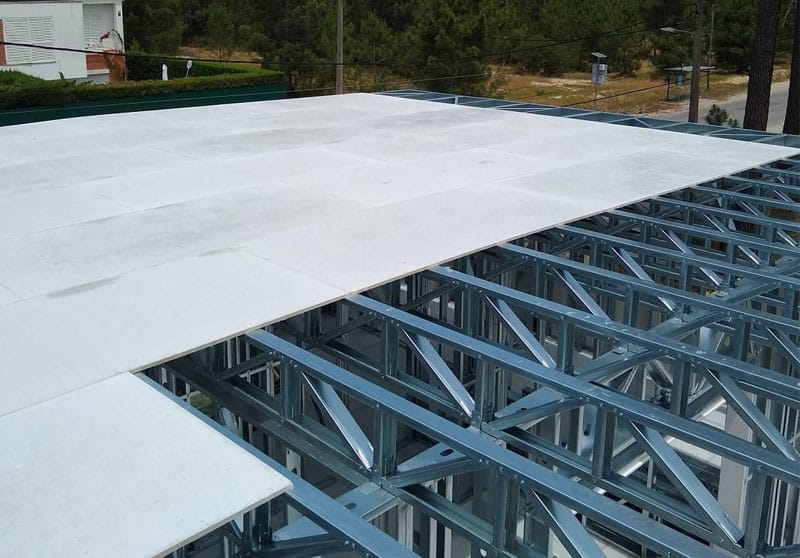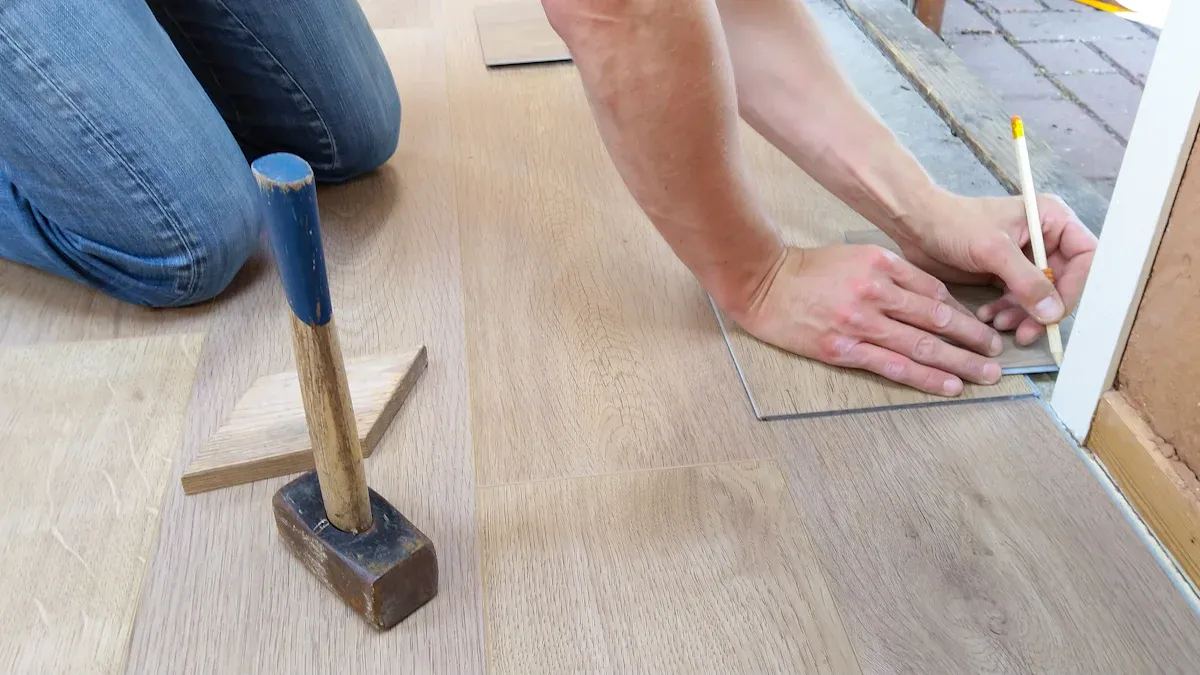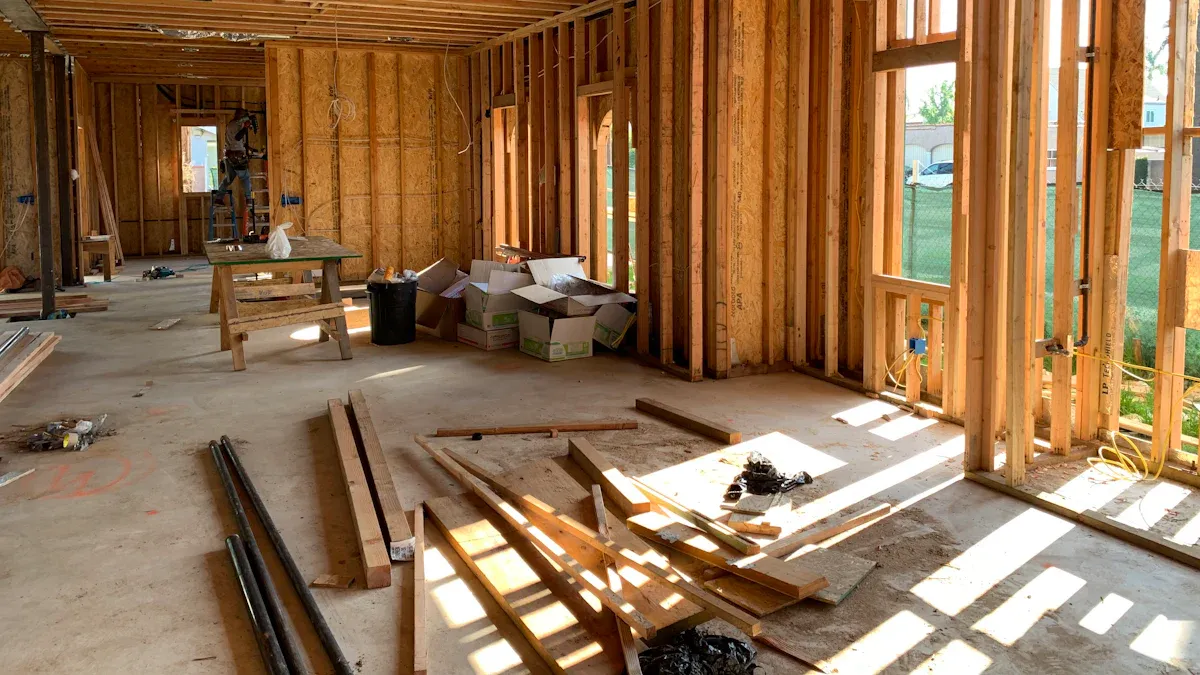
09 Sep The Benefits Of Substrate Flooring
Table of Contents
Understanding the benefits of substrate flooring can lead to floors that last longer and are stronger. If you want your house to feel sturdy and warm, having a strong base under your feet is essential. The benefits of substrate flooring include preventing issues like squeaky sounds, water damage, and bumpy floors.
Key Takeaways
Picking the right substrate material, such as plywood or fiber cement, makes your floors strong. It helps them last a long time.
Substrate flooring stops water damage. This keeps your home healthy. It also helps you avoid expensive fixes.
A good substrate lowers noise. This makes your home quiet. It helps everyone feel more comfortable.
Substrate flooring basics

What is substrate flooring
When you start a flooring project, you might hear the term “substrate flooring.” This is the layer that sits right under your finished floor. You can think of it as the foundation for everything above. If you want your floors to last, you need a strong and stable substrate. It supports your floor and helps prevent problems like squeaks or uneven surfaces.
Most homes use a few common materials for substrate flooring. Here are the ones you’ll see most often:
Plywood: This is the go-to choice for many homeowners. You’ll often find ¾” tongue-and-groove plywood because it locks together tightly and gives great support.
Oriented Strand Board (OSB): OSB looks a bit like plywood but costs less. It’s made from wood strands and resin, pressed into sheets.
Concrete: Some homes, especially those with basements or ground-level floors, use concrete. It’s tough and lasts a long time, but you’ll need a moisture barrier to keep water out.
Tip: If you want your floors to feel solid and quiet, picking the right substrate material makes a big difference.
Substrate vs. subfloor vs. underlayment
You might wonder how substrate, subfloor, and underlayment are different. Here’s a simple way to remember:
Substrate: This is the base layer. It’s what everything else sits on.
Subfloor: Sometimes, people use this word instead of substrate. In most cases, they mean the same thing.
Underlayment: This is a thin layer that goes between the subfloor and your finished floor. It adds extra cushioning, sound control, or moisture protection.
If you know these terms, you’ll find it easier to plan your flooring project. You’ll also avoid mistakes that could cost you time and money.
Benefits of substrate flooring
Durability and stability
Floors should last a long time. Substrate flooring helps make floors stronger and more stable. A strong substrate lets floors hold heavy furniture and lots of people. It also protects against cracks and sagging as time goes by.
Resinous and fluid-applied substrate flooring can handle heavy use. They also resist damage from chemicals.
These types make a smooth surface. This means you do not need to fix them often, and they last longer.
In tall buildings, a solid substrate keeps upper floors steady. This helps keep people safe and floors looking nice.
Think about moving a big couch across your floor. With a sturdy substrate, you will not hear squeaks or feel dips. Your house feels strong, and you know your floors are safe.
Moisture resistance
Water can ruin floors very fast. That is why moisture protection is a big benefit of substrate flooring. Some new substrate materials, like fiber cement boards, do not warp or swell when wet. This makes them great for bathrooms, kitchens, and basements.
Here is how experts check for moisture resistance:
Test Method | Description |
|---|---|
Plastic Sheet Method | Tape a plastic sheet to the substrate for 16 hours to check for moisture. |
Electrical Impedance Moisture Meter | Measures moisture in the top inch without damaging the floor. |
Radio Frequency Moisture Meter | Checks moisture in the top three-quarters of an inch. |
Electrical Conductivity Meter | Uses conductivity to measure relative moisture content. |
Relative Humidity Probes | Measures humidity inside the substrate after drilling a small hole. |
Substrate flooring also stops mold and mildew from growing. Unlike wood or carpet, it does not soak up water. This keeps your home cleaner and healthier, especially in wet places.
Tip: To avoid expensive water damage, always pick a substrate that resists moisture.
Sound insulation
No one wants to hear every noise from other rooms. Substrate flooring helps block sound, so your home stays quiet.
Substrate flooring blocks both air and impact noise. This is important in apartments and shared homes.
Special underlayment can make your floor better at stopping sound from moving between floors.
The right substrate also helps stop squeaks and rattles. This makes your home more comfortable.
If kids run upstairs, you will not hear every step. Downstairs rooms stay peaceful, and everyone gets more privacy.
Thermal comfort
You want your house warm in winter and cool in summer. Substrate flooring helps with thermal insulation and comfort. Some materials, like soil-based flooring, keep floors cooler, which helps your home feel good all year.
Substrate flooring with good insulation keeps heat inside in winter and blocks heat in summer.
Heated floors work better with the right substrate. The heat stays in the floor longer, so you use less energy.
Adding an insulative underlayment raises your floor’s R-value. This makes your home use less energy.
Heated floors keep warmth longer. You do not need to run the heater as much. This saves money and keeps your home warm for longer.
If you want to save on heating and feel more comfortable, the right substrate helps control temperature.
Smooth installation
A flat, even surface makes it easier to put in new floors. This is another big benefit of substrate flooring. When the substrate is smooth, you can lay tile, wood, or carpet without trouble.
Installers like substrates that do not split or rot. This means fewer problems during the job.
Testing for porosity and using the right glue helps your new floor stick well and last longer.
You get a nice-looking floor, even if you install it yourself.
Think about putting new vinyl planks in your kitchen. With a flat surface, the planks fit together just right. You do not get bumps, and your floor looks great.
Note: Substrate flooring does more than look good. A smooth install means fewer repairs and less stress later.
When you add up all these benefits—strength, moisture protection, sound blocking, thermal comfort, and a smooth surface—you see how substrate flooring makes your floors better and your home nicer.
Common issues without proper substrate
 Cracks and sagging
Cracks and sagging
If you skip proper substrate flooring, your floors can start to sag or crack. You might notice dips when you walk or even see cracks in your walls and ceilings. These problems often come from weak support under your floor.
Sagging or uneven floors can happen because of water damage, rot, or even termites.
Cracks in your walls or ceilings often show up when the floor below is not stable.
Foundation issues can get worse if your flooring system does not have enough support.
Soil movement can cause your foundation to shift, especially if water drains poorly.
Concrete slabs may settle if the ground below cannot hold the weight, leading to cracks.
Cracks in concrete can make your whole house less safe.
If you notice your floors feel bouncy or see cracks, your substrate might need attention.
Sound and comfort problems
Without a good substrate, your home can get noisy fast. Hard floors with no cushion underneath make every step sound louder.
The harder your floor, the more noise you hear when someone walks or drops something. Most older homes do not have the right materials to stop these sounds from traveling.
You might also feel less comfortable. Cold floors in winter and loud footsteps above can make your home less cozy.
Repairs get harder because damaged boards need careful cutting to fit on the joists.
Moisture damage
Moisture is a big enemy for floors without proper substrate. Water can sneak in and cause all sorts of trouble.
Warping and buckling happen when wood gets wet and starts to swell or shrink.
Mold and mildew love damp places and can grow under your floors, making your home unhealthy.
Adhesive floors can lift or shift if moisture breaks down the glue.
Tip: Always check for moisture before installing new floors. This simple step can save you from big repairs later.
Getting the most from substrate flooring
Material choices
Choosing the best substrate flooring material helps your floors last. You might think about price first, but how long it lasts is important too. Tile flooring costs more at the start, but it stays nice and clean for years. This is great for busy rooms like kitchens. Polished concrete costs less to put in, but it can crack and soak up water. You may need to fix it more often. Quarry tile works well in places with lots of people walking. It does not need much care and does not wear out fast.
Material | Upfront Cost | Durability | Maintenance Needs |
|---|---|---|---|
Tile Flooring | High | Excellent | Low |
Polished Concrete | Low | Good | Moderate-High |
Quarry Tile | Medium | Excellent | Low |
Installation tips
If you want strong floors, follow expert advice. Use the right tools like a utility knife, tape measure, and rubber mallet. Make sure your subfloor is clean, dry, and flat before you start. Measure your room and plan how you will lay the floor. This helps you install hardwood flooring or other types easily.
Tip: Put glue on one panel at a time. Fasten each panel as you go. Glue the tongue-and-groove to stop movement and noise.
Try not to make these mistakes:
Gluing too many panels at once
Using fasteners that do not fit
Forgetting moisture protection
Not letting the subfloor get used to the room
Picking the wrong thickness
Maintenance
Taking care of substrate flooring is simple if you do it often. Sweep or vacuum to get rid of dirt that can scratch the floor. Be careful with chemicals so they do not harm the coating. Look for small problems and fix them before they get worse. If you want hardwood flooring to last, regular care is important. A good substrate makes your floor feel softer when you walk.
When you pick the right substrate flooring, your home gets better. Your house will be stronger, quieter, and more comfortable. Here are some main benefits:
Benefit | Description |
|---|---|
Protection From Moisture | Keeps water out and stops mold. |
Sound Reduction | Makes your rooms less noisy. |
Cushioning | Feels softer when you walk on it. |
Insulation | Helps keep your floors warm. |
Added Stability | Stops problems with your floors. |
Experts say, “Getting the substrate ready is very important before you put in new floors. It can change how your floors look and how long they last.”
To choose the best one, think about each room. Check for water problems and know your budget. The choices you make now help your floors stay nice for a long time.
FAQ
What makes substrate flooring important for hardwood floors?
You get a strong base for hardwood. Substrate flooring stops squeaks and keeps your floor flat. Your hardwood lasts longer and feels solid under your feet.
Can substrate flooring help with moisture problems?
Yes, you avoid water damage with the right substrate. It blocks moisture, so your hardwood stays dry. You also prevent mold and swelling in your floors.
What are the benefits of underlayment with substrate flooring?
You add comfort and sound control. Underlayment cushions your hardwood and makes rooms quieter. You also get extra protection from moisture and a smoother surface for installation.

 Cracks and sagging
Cracks and sagging